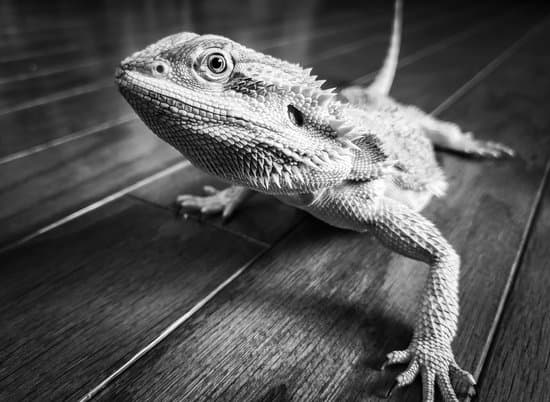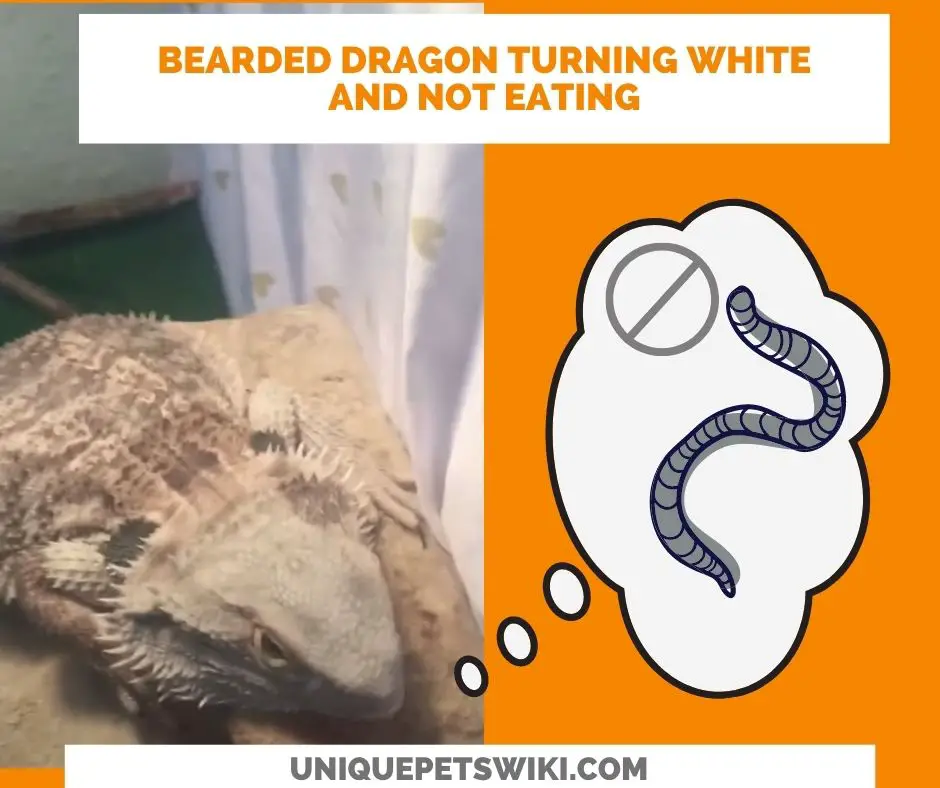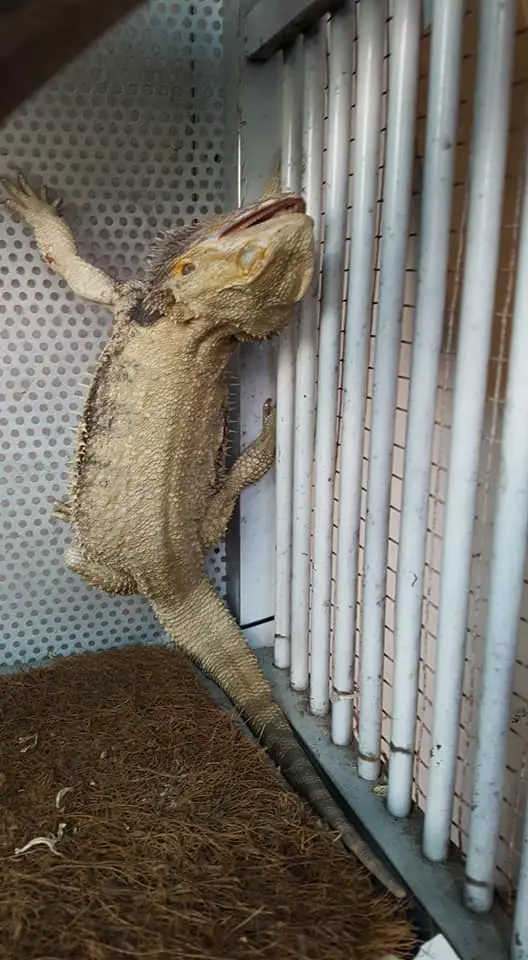Bearded dragons turning white is common and happens for different reasons. So, should you be worried when your lizard turns white? Is it something normal?
Bearded dragons are capable of changing color to specific body parts depending on various factors. Seeing a dragon turning white can be strange, especially if you are a new reptile keeper or enthusiast.
Here, we will learn why bearded dragons turn white, how you need to respond, and lots more.
This article has been reviewed by Dr. Dilber. Read more about our knowledge control process here.
Contents
What is the Meaning of a Bearded Dragon Turning White?

You might view your lizard as being cold and dumb and unable to communicate as many people do. However, that’s pretty far away from the real truth.
The truth is that bearded dragons can communicate their mood, feelings, and health by expressing various behaviors. Some of these behaviors include body-color change, showing a black beard, arm-waving, head-bobbing, etc.
A bearded dragon can turn its body white or particular parts, including the legs, tail, head, mouth, and nose. Let’s find out why bearded dragons turn to white.
A Bearded Dragon Turning White When Preparing to Shed
The most common reason why the beardies turn white is because of shedding. Shedding is a normal process, and it occurs more often (after every few weeks) in baby bearded dragons since they are growing tremendously.
As the beardies continue to grow, the shedding rate decreases and the adults usually shed a few times a year.
So, when shedding is approaching, the top skin in beardies is likely to turn white or pale, which can happen in patches. This should not make you worry at all. Typically, bearded dragons shed in patches, and the process can last for about 2-3 weeks.
if a bearded dragon has an underlying health issue it takes 3 weeks otherwise it takes 1 or 2 weeks to shed normally.
Ensure the humidity in the enclosure is 30-40% and mist the lizard once a day to encourage it to shed naturally and easily. In case you notice some old skin remaining, always bathe your pet in lukewarm water to soften the skin, but don’t assist it in shedding.
Color Change in Bearded Dragons Due to High Temperature
It is usual for bearded dragons to turn white or black because of the variation in temperatures. For instance, when a beardie gets cold, it will become darker, which helps it absorb as much heat as possible and within a shorter time.
On the other hand, a bearded dragon can turn white when it gets pretty hot to absorb less heat. So, if you notice your dragons turning white and it’s not about to shed, you will have to check the temperature in the tank.
Bearded dragons must have warmth for them to digest food effectively and thrive. It would help if you kept the temperatures within the required range, depending on your beardie’s age. For the babies, the basking spot should be around 110℉ and the cool spot 85-90℉.
Adults require a warm basking spot of about 100-105℉, and the cool side should be between 80-85℉. To monitor the temperatures and ensure they are within the necessary range, you need to have a digital thermometer.
Bearded Dragon Turning White when Sleeping
A bearded dragon can turn white while sleeping, and this is perfectly normal. Researches reveal that the lighter shade is due to the bearded dragon’s circadian rhythm.
There are some arguments that the beardies turn white at night to show that they are relaxing and comfortable while sleeping, which isn’t unusual.
If a bearded dragon turns white while sleeping, you should notice the body parts that turn white. If all the body extremities are turning white then it is due to any underlying health issues. However, if you notice a few body extremities like the front face and arm, it is normal while sleeping.
Also, when the tank temperatures are too high at night, above 75℉, bearded dragons are likely to turn to a lighter shade. So, a bearded dragon turning white and sleeping is not always a big concern, but sometimes it can indicate something unusual.
For that matter, you need to chat with your reptile vet or any other experienced reptile expert and get advice from them.
Why Is My Bearded Dragon Turning White and Not Eating?

Although a bearded dragon turning white is not something of great concern, there are times when a lizard turns white, and it is not eating. If you see such signs, and the beardie also seems sluggish, this is a bad sign and can indicate that the beardie is dying.
You can also spot a dying bearded dragon by looking at its beard, which appears black while the tail, limbs, and face are pale. A dragon can reach such a point due to impaction, parasites, or it is at its old age. Bearded dragons also turn white due to a deficiency of calcium and vitamin D3. It may also be due to organ damage such as kidney damage.

In case of a sudden change in color and typical behavior, make sure to check for impaction. Impaction can result from the dragon consuming substrate, large objects, or indigestible chitin from insect feeders.
When the bearded dragon has digestive issues such as impaction or indigestion, its color will suddenly turn white. Because the digestive organs secrete the enzymes to digest the ingested material which speeds up the metabolism. As a result, the temperature increases due to the release of heat as a by-product of metabolism. So, in such cases, it is necessary to lower the temperature of the tank.
Please ensure you pay a visit to a reptile vet any time you witness your bearded dragon appearing white and is keeping off from food.
Bearded Dragon Tongue Turning White
Typically, the beardies tongue’s tip tends to vary from light pink to white, and it is a little bit sticky. This kind of texture is a physical adaptation that allows bearded dragons to seize their prey quickly.
So, the paleness in the tip of the tongue is usual in bearded dragons, but the entire mouth becoming pale is a dangerous sign.
A white throat and tongue show there may be a health issue. The pet could have parasites, anemia, or other disorders. When in such a condition, it is good to take the dragon to a reptile vet for a checkup.
The coloring of the tongue actually reflects the digestive health of the bearded dragon. The white coloring of the tongue ensures there is something wrong with the digestive system. Sometimes you may also notice diarrhea, or loose stool when the tongue is white.
Bearded dragons express multiple behaviors under different circumstances, and some of them might seem weird, especially to new dragon keepers. It’s important to be familiar with the potential behaviors in these pets and understand their meaning.
It is only after distinguishing what each behavior stands for that you will be able to act accordingly.
Fully understanding your bearded dragon will help you better take care of them. As a suggestion, we would recommend you to get a good bearded dragon book. Not to become an expert on bearded dragon care but will help you avoid the common mistake in new pet lizard owners.
Last update on 2022-12-30 / Affiliate links / Images from Amazon Product Advertising API
Bearded Dragons’ Head And Tail Turning White
When bearded dragons are about to shed, they will turn white. One interesting fact with bearded dragons is that they don’t shed their whole bodies as other lizards do. They shed in patches or phases.
Sometimes they may shed a combination of body parts. For example, they can shed only one side of the body, either the legs and tail, or the head and the tail, or only one part at a time.
Thus, when you see this happening, you shouldn’t panic because it’s a healthy sign that your lizard is in good shape. Whichever is the part your dragon is shedding at the moment, that part will turn white. This color change will remain like that until the shed is completed.
In simple terms, what this means is that when your bearded dragon is about to shed its head, the head will turn white. When it’s about to shed its tail, its tail will turn white. The same thing applies to every other part that is currently in a shed.
Sometimes bearded dragons take a longer time to shed. This too is normal. Juveniles and young bearded dragons shed more often than adult beardies. The older they get, the longer time it takes for them to successfully shed.
For this reason, adult bearded dragons only shed a few times in a year. And it takes longer days to weeks to complete a shed.
Bearded Dragon’s Body Turning White And Not Eating
Bearded dragons turning white isn’t a symptom of anything bad. As explained above, they’re all healthy signs. But when your bearded dragon turns white and is not eating, then something is wrong.
This is the only time you can get worried about your lizard’s health. So, what does it mean for bearded dragons to turn white and not eat? This is a sign that your bearded dragon is in poor health or may even be dying.
Turning white or to any other color for bearded dragons is one of their major ways of communicating with their owners. Hence, when they turn white and it is accompanied by other odd behaviors, you should know that your bearded dragon is dying.
Other odd behaviors that may follow the color change include not eating, runny or smelly stool, lethargy, weight loss, cloudy or filmy eyes, etc.
Bearded Dragon Dying Signs
Bearded dragons like other lizards communicate to their owners through body language. One of these body languages is to turn white for specific reasons.
Except for the case of bearded dragons turning the whole body to white and they have eye-closing problems; this color change has nothing to do with its health unless followed by other health-related symptoms. Some of the symptoms include:
- Lethargy. Inactivity as a result of a small cage may not be as serious a thing of concern as that resulting from a poor cage setup. Lethargy as a result of poor heating is a serious issue to look into before it becomes serious.
- Cloudy or filmy eyes. The eyes of a healthy bearded dragon are clear, bright, and alert. But during shedding, their eyes can appear dull or cloudy.
This is nothing to worry about. However, if the cloudy eyes give out discharges, then something is wrong with its health.
- Soft, runny, or smelly stool. This may mean that your bearded dragon may be having internal parasites.
- Swollen limbs or tail. This may be caused by a fractured or broken limb or tail.
- Not eating (loss of appetite). Many factors can be responsible for this. Stress and wrong cage set up can contribute to loss of appetite.
- Gasping for air. One of the symptoms of Metabolic Bone Disease (MBD) in bearded dragons is a slack jaw. If your lizard is constantly keeping its mouth open and has difficulty holding on to food, your lizard likely has a slack jaw.
- Discolored or black mouth. Usually from the inside.
- Boney or appearing malnourished.
- Discolored stomach.
- Sunken eyes.
- Bloody or damaged snout.
Wrapping Up
Uninformed new keepers get worried sick when they see their bearded dragons become light or white all of a sudden. They usually think that something bad has happened to their lizards.
After reading this article, you should know when to show concern when your lizard turns white. Moreover, the information in this article will give you an edge over other pet owners.
It’ll also help you educate other new pet bearded dragon owners about their color change.

